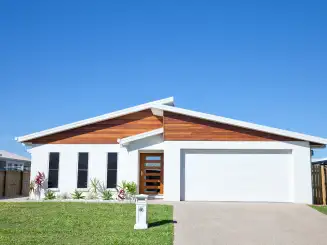What is a HomeReady® loan?
The HomeReady® home loan is Fannie Mae’s mortgage program for low- or moderate-income consumers with a low down payment. All you need is 3% down to get through the door of your new home. That 3% down payment is a huge weight off your shoulders compared to the 20% most loans require. HomeReady® loans also let you mix and match where that cash comes from. Rather than your own wallet, you can pull from gifts and grants.
You’ll still need to budget for private mortgage insurance because of the lower down payment. The good thing is it won’t last forever. Once you hit 20% equity, you can ask for mortgage insurance to be taken off the bill. And if you’re really strapped for cash and make 50% or less of the area median income, you may be able to get a credit towards the down payment or closings costs. To put HomeReady® into motion, you’ll need to take a homeownership counseling course which is required to be eligible for the program. This resource is there to make sure you’re all caught up on the tools you need to be a savvy homeowner.
Pro Tip
You can see if you qualify for the HomeReady® $2,500 credit towards a down payment or closing costs using Fannie Mae’s area median look-up tool.
How do HomeReady® loans work?
If you’ve dipped a toe in the mortgage world, you’ve probably heard of the creator of HomeReady®, Fannie Mae. Fannie Mae is a government-sponsored entity that works in the secondary mortgage market and helps set guide rails for the industry. This means Fannie Mae doesn't directly lend money to home buyers but instead buys and guarantees payments through lenders. This system keeps the mortgage world moving and frees up funds so lenders can keep giving loans to hopeful home buyers like you.


The guarantee fee
Fannie Mae and Freddie Mac are government sponsored entities that promise to cover the principal and interest on their mortgage-backed securities and, for this service, they charge what's called a guarantee fee, or g-fee for short.
HomeReady® loan requirements
We’ve covered the basics, but there’s a few HomeReady® loan guidelines you should know. First, you may need a credit score of at least 620. Alongside your credit score, a lender will look at your debt-to-income ratio. This percentage shows how much of your monthly income goes towards paying off debt. HomeReady® is more flexible than other loans and could accept up to a 50% DTI ratio—but the lower, the better. A lower figure shows lenders that you're in a healthy spot financially because you're not using a lot of your income to pay debts.
If HomeReady® is sounding pretty good to you, make sure you check all the boxes of a qualified borrower. Here’s a quick summary of the major marks you may want to hit.
- Credit score of 620+
- Debt-to-income ratio of 50% or less
- Income at or below 80% of the area median income
- Minimum down payment of 3% which can come from gifts, grants and programs
- Must be your primary residence
- Required private mortgage insurance
- Mandatory home buyer counseling course
What is a Home Possible® loan?
Another loan program that focuses on low to moderate income consumers is Freddie Mac’s Home Possible® loan. It has similar program features to HomeReady®, with a few key differentiators. Like HomeReady®, Home Possible® can also help you score a 3% down payment, similar income limits and the ability to use gift funds or grants for the down payment.
Pro Tip
If you're renting with a roommate and thinking about purchasing a home, the HomeReady® and Home Possible® programs allow you to use your roommate's rent payments as "boarder income" to help qualify for a mortgage. Just make sure you have documentation of your roommate's rent payments for at least the last nine months and proof of cohabitation for the last 12 months.
Similar to HomeReady®, you can’t get around private mortgage insurance with Home Possible® either. You’ll be expected to keep up with mortgage insurance payments until you’ve paid off 20% of your home’s ticket price.
How does a Home Possible® loan work?
You already had a peek into how HomeReady® works, and Home Possible® operates much the same way, just under the wing of a different government-sponsored entity, Freddie Mac. That means if you have Home Possible and you stop making payments, lenders can expect Freddie Mac to step up and cover the costs. To prevent this, Freddie Mac makes sure Home Possible® borrowers are well-prepared to take on the title of homeowner—from a mandatory homebuying counseling course that gets you in tip-top shape to providing helpful resources along the way.
Home Possible® loan requirements
We’ve hit a lot of the high notes of the Freddie Mac Home Possible® loan, but let’s go over all the details in one place. If you’re considering applying for a Home Possible loan, make sure you’re aware of the following requirements:
- Credit score of 660+
- Debt-to-income ratio of 43% or less
- Income at or below 80% of the area median income
- Minimum down payment of 3% which can come from gifts, grants and programs
- Must be your primary residence
- Required private mortgage insurance
- Mandatory home buyer counseling course
Comparing HomeReady® & Home Possible® loans
You might think HomeReady® and Home Possible® are mirror images up to this point, but that’s not quite the case. Home Possible® may be a hair stricter when it comes to approval. You’ll need a higher credit score of at least 660 and a lower debt-to-income ratio, coming in at about 43% or less.
On the other side, HomeReady® may be more lenient, accepting FICO scores of 620 and DTI ratios of up to 50%. Set aside some time to double check your credit score and run the numbers on your DTI ratio.
Ultimately, the biggest difference between HomeReady® and Home Possible® boils down to what it takes to qualify.
Want to compare HomeReady® and Home Possible®? Here’s all the information you need to size them up:
| Homeready® | Home Possible® | |
|---|---|---|
| Minimum down payment | 3% | 3% |
| Mortgage insurance | Yes, until 20% home equity is reached | Yes, until 20% home equity is reached |
| Income limits | 80% of AMI | 80% of AMI |
| Minimum credit score | 620 | 660 |
| Flexible down payment and closing costs | Yes | Yes |
| Required homeownership education | Yes | Yes |
Alternative options to the HomeReady® & Home Possible® loans
Before you decide which way to go, let’s take a look at what else is on the table.
The Federal Housing Administration (FHA) offers a low down payment loan, with down payments of 3.5% or more alongside the need for mortgage insurance. FHA also requires a credit score of 580 or higher.
If you are a veteran, a Veterans Affairs (VA) loan could be an option for you. These programs are available to veterans, service members and eligible surviving spouses and offer a 0% down payment, if you have 100% of VA Loan Guarantee Benefit, with no private mortgage insurance required. They also offer competitive interest rates. VA loans typically look for credit scores of 620 and a DTI ratio of 41%.


Citi HomeRun™ mortgage
Citi has a special low-down payment program, a great option that helps you put as little as 3% down with no private mortgage insurance. HomeRun™ also permits gift and grant funds to cover the down payment after the first 1%. This program is only offered in select markets and income limitations may apply.
Have questions? Our team can help!

